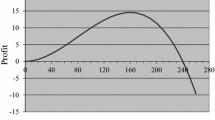Abstract
In the profitable tour problem, the carrier decides whether to visit a particular customer with respect to the prize the customer offers for being visited and traveling cost associated with the visit, all in the context of other customers. Our focus is on the prizes customers need to offer to ensure being visited by the carrier. This can be formulated as a cooperative game where customers may form coalitions and make decisions on the prize values cooperatively. We define the profitable tour game describing this situation and analyze the cost associated with each coalition of customers and prizes that help to achieve it. We derive properties of the optimal prizes to be offered when the grand coalition is formed. These properties describe relationship between the prizes and the underlying traveling salesman game to provide connection with extensive literature on core allocations in traveling salesman games. The most important result states that the set of optimal prizes coincides with the core of the underlying traveling salesman game if this core is nonempty.


Similar content being viewed by others
Notes
A question could be raised of which ones of the customers should increase the prize. This might open a long discussion since arguably every individual customer wants to minimize its own prize. However, in the cooperative game-theoretical framework we adopt, the increment could be already reflected in the cost function value \(\text{ Cost }^{TSP}(\{1,2,3\})\). Thus, the increment gets allocated in a manner that is fair according to the chosen allocation method (the nucleolus in this example).
References
Archetti, C., Speranza, M.G., Vigo, D.: Vehicle routing problems with profits. In: Toth, P., Vigo, D. (eds.) Vehicle Routing: Problems, Methods, and Applications, 2nd edn, pp. 273–297. SIAM, Philadelphia (2014)
Engevall, S., Göthe-Lundgren, M., Värbrand, P.: The traveling salesman game: an application of cost allocation in a gas and oil company. Ann. Oper. Res. 82, 203–218 (1998)
Estévez-Fernández, A., Borm, P., Meertens, M., Reijnierse, H.: On the core of routing games with revenues. Int. J. Game Theory 38(2), 291–304 (2009)
Feillet, D., Dejax, P., Gendreau, M.: Traveling salesman problems with profits. Transp. Sci. 39(2), 188–205 (2005)
Fishburn, P.C., Pollak, H.O.: Fixed-route cost allocation. Am. Math. Mon. 90(6), 366–378 (1983)
Guajardo, M., Jörnsten, K.: Common mistakes in computing the nucleolus. Eur. J. Oper. Res. 241(3), 931–935 (2015)
Guajardo, M., Rönnqvist, M.: A review on cost allocation methods in collaborative transportation. Int. Trans. Oper. Res. 23(3), 371–392 (2016)
Kimms, A., Kozeletskyi, I.: Core-based cost allocation in the cooperative traveling salesman problem. Eur. J. Oper. Res. 248(3), 910–916 (2016)
Laporte, G.: What you should know about the vehicle routing problem. Nav. Res. Logist. 54(8), 811–819 (2007)
Laporte, G., Martín, I.R.: Locating a cycle in a transportation or a telecommunications network. Networks 50(1), 92–108 (2007)
Potters, J.A.M., Curiel, I.J., Tijs, S.H.: Traveling salesman games. Math. Program. 53(1–3), 199–211 (1992)
Schmeidler, D.: The nucleolus of a characteristic function game. SIAM J. Appl. Math. 17(6), 1163–1170 (1969)
Šomplák, R., Nevrlý, V., Málek, M., Pavlas, M., Klemeš, J.J.: Network flow based model applied to sources, sinks and optimal transport of combustible waste. Chem. Eng. Trans. 61, 991–996 (2017)
Sudhölter, P.: The modified nucleolus as canonical representation of weighted majority games. Math. Oper. Res. 21(3), 734–756 (1996)
Sun, L., Karwan, M.H.: On the core of traveling salesman games. Oper. Res. Lett. 43(4), 365–369 (2015)
Sun, L., Rangarajan, A., Karwan, M.H., Pinto, J.M.: Transportation cost allocation on a fixed route. Comput. Ind. Eng. 83, 61–73 (2015)
Tamir, A.: On the core of a traveling salesman cost allocation game. Oper. Res. Lett. 8(1), 31–34 (1989)
Tarashnina, S.: The simplified modified nucleolus of a cooperative TU-game. TOP 19(1), 150–166 (2011)
Author information
Authors and Affiliations
Corresponding author
Additional information
Publisher's Note
Springer Nature remains neutral with regard to jurisdictional claims in published maps and institutional affiliations.
Rights and permissions
About this article
Cite this article
Osicka, O., Guajardo, M. & Jörnsten, K. Cooperation of customers in traveling salesman problems with profits. Optim Lett 14, 1219–1233 (2020). https://doi.org/10.1007/s11590-019-01429-6
Received:
Accepted:
Published:
Issue Date:
DOI: https://doi.org/10.1007/s11590-019-01429-6




